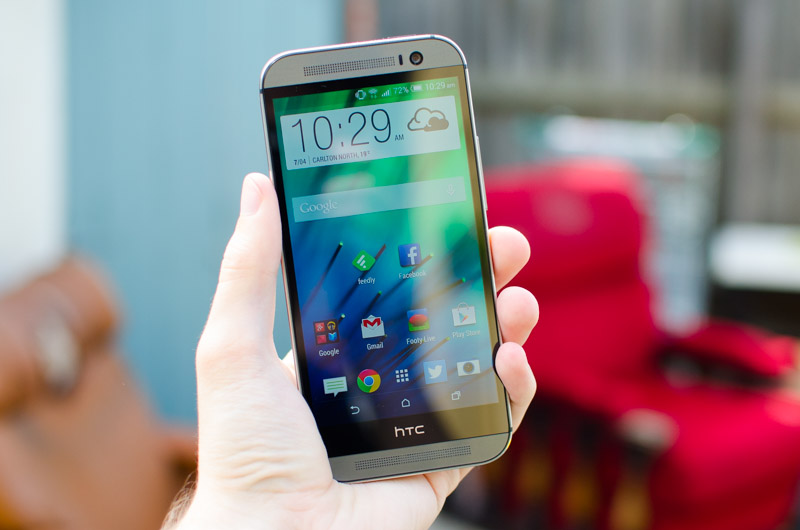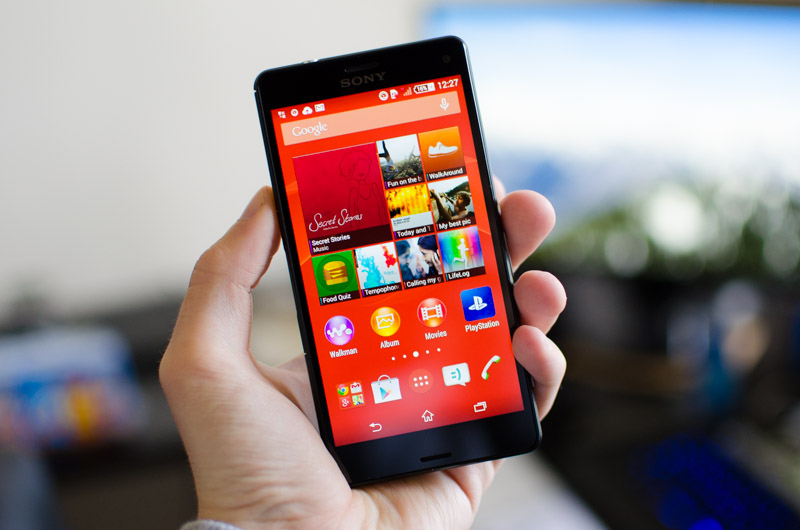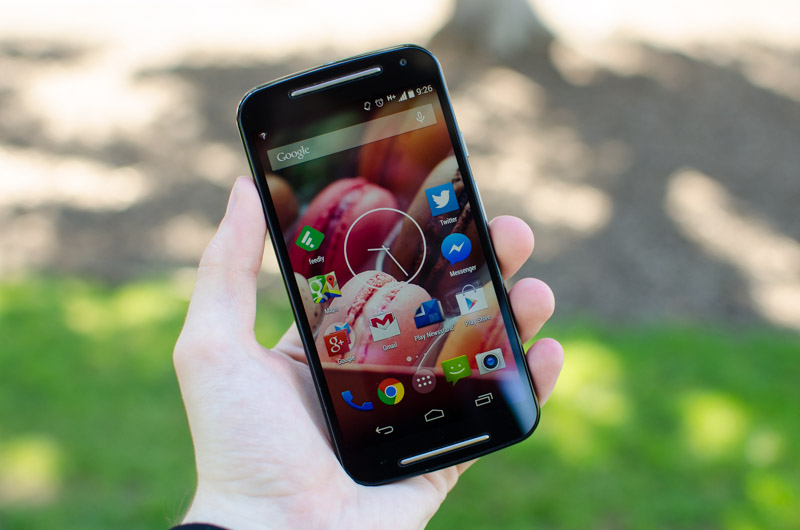The Best Android Phones of 2022
Information technology's coming to that time of the year when you might want to grab a new smartphone either for yourself, or equally a gift for someone during the holiday season. Virtually of the phones that will be coming out this year have been appear or launched, and so if yous want to make upwardly your listen about upgrading, this is as stable equally information technology gets in the smartphone globe.
Throughout the year I have reviewed and got hands-on time with plenty of devices, especially from the Android camp but because there'south such a sheer volume of them on the market today. I've used all the flagships from HTC, Samsung, LG, Motorola, Sony, and more than -- some of those reviews are withal in the pipeline -- and below I've compiled my thoughts on what's currently the best out in that location.
HTC One (M8)

HTC was one of the first to launch a flagship Android smartphone this year and the fact that the HTC One M8 is making information technology to this list is testament to the great job they did with it. Built on the principles HTC established with the original One in 2022, adding in new hardware such every bit the Duo Camera and refining the aluminum design.
What I Liked
At that place's a lot to like about the One M8, merely if I had to cut it down to simply ane matter, it'd probably exist the design. The aluminum unibody looks great and feels awesome to agree. HTC improved the ergonomics considerably over the previous-generation 1 and managed to raise the BoomSound speakers in the process. Of all the Android handsets released in 2022, the 2d-generation 1 definitely looks the best.
What I Didn't Like
As much as the Duo Photographic camera is an interesting feature that allows y'all to utilize cool furnishings to your photos, the photographic camera every bit a whole is underwhelming. Compared to the contest, the HTC One M8 simply can't keep upward in virtually conditions, especially in terms of resolution where the four megapixel sensor disappoints. It may accept an advantage in low light scenarios, but the new Ane is far from a high quality flagship camera.
Samsung Galaxy S5

There were no surprises when Samsung announced their latest loftier-finish device, the highly anticipated Galaxy S5. Packing a new fingerprint sensor and eye rate monitor, Samsung made a big deal of the device being suited for fitness and action, packing top notch hardware into a waterproof example for the first time.
What I Liked
Information technology's a tossup between the display and photographic camera for what I like the virtually, with the latter simply edging it out. It'southward not the greatest in dark weather condition with its f/2.two lens and one.12µm pixels, but at all other times it excels. The 16-megapixel sensor is simply fantastic in sunlight, delivering abrupt, accurate and vibrant images loaded with item. The provided HDR mode is likewise by far the best of whatsoever smartphone, and 4K recording is always a handy inclusion.
What I Didn't Like
The aforementioned fingerprint scanner and heart rate monitor are gimmicks, failing to brand whatsoever meaningful improvement to the smartphone and not necessarily performance perfectly. On top of that Samsung's design however feels backside the competition. Though there were improvements in this area, it still looks and feels cheap, which is less than ideal for an expensive flagship.
LG G3

The LG G3 was no minor revision to the well-regarded G2. The company packed in new and improved hardware, including a v.5-inch Quad HD display and the laser autofocus assisted 13-megapixel photographic camera with OIS, every bit well as a much ameliorate software offering.
What I Liked
The edge-to-edge v.5-inch IPS LCD display is one of the standout features of the G3, and makes me want to come back and use it regardless of which smartphone I'm reviewing at the time. There isn't a huge difference in clarity between the Quad Hd resolution and similar 1080p panels, but the sharpness is definitely impressive. Paired with dandy color quality and a decent corporeality of real estate in a surprisingly compact trunk, the G3'south display is a definite favourite.
What I Didn't Like
The new display comes with the downside of a having hit on functioning and battery life. The G2 carried meridian of the line bombardment life but the same can't be said of the G3. The performance hit isn't as of import, though in some taxing 3D games the GPU simply tin't render frames as oft as it tin on a 1080p handset.
Sony Xperia Z3

Sony has released two flagship smartphones this yr cheers to their foreign half dozen month release cycle, the start being the quite decent Xperia Z2, and now the Z3. Information technology's a small upgrade on what came before information technology, though the changes help refine the package and make for a very well-rounded device.
What I Liked
The entire handset feels similar a meridian-notch, premium product that delivers both on a design and hardware perspective. Nosotros're talking about a waterproof aluminum torso, Snapdragon 801 SoC within, twenty-megapixel rear photographic camera, and neat bombardment life. That last betoken is especially crucial, with Sony clearly understanding how of import it is to have a long-lasting smartphone.
What I Didn't Like
Information technology would appear the Xperia Z3 is lacking a "killer feature" simply there are no obvious omissions either. As well, Sony'southward smartphone strategy at the moment is somewhat unclear: releasing a new flagship every half dozen months make buyers of the Z2 feel like their handset is outdated quite rapidly. Will this happen once again with the Xperia Z3? I sure hope non.
Sony Xperia Z3 Meaty

Alongside the Z3, Sony released the Z3 Compact catering to folks who don't want such a large handset. With a iv.6" display and essentially the same internal hardware every bit the Z3, the Z3 Compact is a bang-up choice if size (and battery life) are major considerations.
What I Liked
The Z3 Compact is ane of the few Android smartphones on the market that combine flagship hardware with a smaller-than-usual form factor, and does so successfully. Not everyone wants a 5.ii-inch or v.5-inch phone, and so the four.6-inch Z3 Compact is very attractive in this respect. Permit's not forget information technology also has a powerful Snapdragon 801 inside, waterproof body, and the aforementioned xx-megapixel photographic camera from the Z3, plus astonishing battery life.
What I Didn't Like
For the marketplace this smartphone is occupying, there's not much to dislike. Still, as with the Z3, I'm non a huge fan of Sony's software skin that fails to add any interesting, standout features, and it does look a bit antiquated in comparison to stock Android and contempo skins from HTC or LG.
Motorola Moto 10 (2014)

The original Moto X was a oversupply favorite fifty-fifty though it skipped on high-cease specs, it made up with phenomenal ergonomics and customization options. This year Motorola has released a new version, including better hardware, a refined design with a larger AMOLED display, and improved software.
What I Liked
In that location are ii aspects to the Moto X working in tandem that arrive such an attractive device. First is the new and improved hardware which includes a powerful Qualcomm Snapdragon 801 SoC, similarly attractive ergonomics, an first-class 5.2-inch 1080p display and much-needed camera upgrade. Combined with excellent contextual software and ever-on vox controls, the new Moto X is a great mix of solid hardware and software.
What I Didn't Like
Some aspects are still slightly behind the competition, notably the camera and bombardment. The 2022 Moto Ten may be far alee when software is concerned with a very clean Android experience, just some of the always-on features hamper battery life, which doesn't announced to be equally adept as its competitors. The camera, while improved, also fails to stand to the flagship powerhouses in this area.
Samsung Galaxy Annotation iv

Samsung has been perfecting the large-screen Annotation formula for a few years at present, and with a refined blueprint and cutting-edge hardware, this is best Android phablet even so.
What I Liked
The use of metal around the edges of the Galaxy Notation four finally makes this handset feel premium. Samsung has listened to the past criticism and noticeably improved the design, and I welcome it. Meridian notch operation is a given (Snadragon 805 or Exynos 5433 within), and OIS adds to an already great camera sensor. If yous don't mind the size, it'southward the best Samsung device in the market.
What I Didn't Like
TouchWiz withal seems bloated and visually mediocre, every bit Samsung hasn't put a huge corporeality of emphasis on changing what they delivered in the Galaxy S5.
What Near The Mid-Range?
Understandably you might not desire to fork out $500+ for any one of the flagships I've mentioned above. And so what smartphone would I recommend for those out in that location who are looking to save a bit of cash?

The second-generation Moto G. For just $179, you go a high quality 5-inch brandish, a very good camera for the price point, and decent performance. On top of that, Motorola gives you stock Android with a few first-party and genuinely useful applications, making it my affordable smartphone of choice. The one primary downside is that the handset doesn't come up with LTE, which is definitely disappointing, though for the price information technology's hard to complain.
Source: https://www.techspot.com/article/897-best-android-smartphones-2014/
Posted by: dominguezhatook.blogspot.com


0 Response to "The Best Android Phones of 2022"
Post a Comment